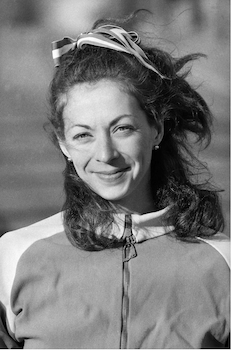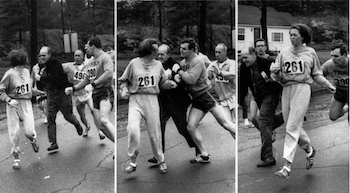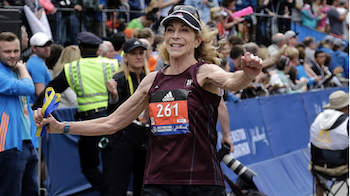
Kathrine Switzer was born to a military family in Amberg, Germany on January 5, 1947. Her parents—Virginia Miller and Homer Switzer—met at the University of Illinois Urbana-Champaign and married in 1940. Switzer’s father was part of two military fraternities and the Reserve Officers Training Corps (ROTC) and went on to become a US Army Major. Two years after her birth, they moved to Fairfax County, Virginia and she went to George C. Marshall High School in Falls Church, Virginia. As a teenager, she played field hockey as well as basketball, and she liked to run often. Switzer attended Lynchburg College before transferring to Syracuse University in 1967, where she earned a B.A. in journalism and English. In 1972, she also received an M.S. in public relations from the Newhouse School of Public Communications at Syracuse University. At Syracuse, she ran with the Men’s Cross Country & Track team because there was no women’s running team anywhere nearby. There, she trained with Arnie Briggs—a 50-year-old coach who served as Syracuse’s mailman and had run in 15 Boston Marathons. He was excited to have a woman running with the men’s team for the first time and she would, over time, open his mind to women’s running abilities.
Briggs frequently shared his Boston Marathon experiences with Switzer during their training. One day, as he continued to tell her more stories, she decided: why not compete in the Boston Marathon herself? At first, Briggs was reluctant, saying she had to first show him that she was capable of running such a long distance. Nevertheless, after demonstrating to him she could, he was convinced of her ability to compete.
The Boston Marathon was first established in 1897 by John Graham, inspired by the Olympic marathon. However, at first, women were unofficially not allowed to compete, as they were seen as “physiologically incapable” of running long distances. For 70 years, the Boston Marathon had been an all-male event. Yet, in 1966, Bobbi Gibb was the first woman to run the entire marathon, but she was not allowed to sign up after inquiring. So, she ran unofficially, further breaking the prevalent gender barrier at the time.
Switzer and Coach Briggs first checked the Boston Marathon’s rulebook, which made no mention of gender, and she decided to sign up as “K.V. Switzer.” She often used her initials to avoid complications as her birth certificate had a misspelling. It was planned: Switzer would run alongside Coach Briggs, her boyfriend Big Tom Miller, who was a 235-pound ex-all-American football player, and John Leonard from the Syracuse cross-country team in the 1967 Boston Marathon. Initially, she wore a hoodie with a hood that covered her head, but as she passed other men who noticed she was a girl, they got excited. Switzer and her group started off at a steady pace, and soon a flatbed truck drove by to photograph her. However, a Boston Marathon race manager, Jock Semple, hopped off the truck and chased after her, saying “Get the hell out of my race and give me those numbers!” as he tried to take off her bib number. Luckily, Big Tom blocked and took him out. The photo of the incident is now one of Time-Life’s “100 Photos That Changed the World” collection. After this moment, Switzer was stunned, but resolved to finish the race to show that women are capable of running marathons and achieving the same goals as men. However, the journalists on the truck became more aggressive, asking her “What are you trying to prove?” and “When are you going to quit?” Nevertheless, she kept on tirelessly going, with the support of Coach Briggs. When she finally passed the finish line in 4 hours and 20 minutes, her socks were blood-soaked from blisters.

At 10 p.m. that same day, they started driving to Syracuse, and at 1 a.m. they stopped at a freeway stop for food and gas. They saw a man at the counter reading a newspaper featuring her picture, and she was surprised to learn that her story had appeared in multiple newspapers as the first woman to officially run the Boston Marathon.
This historic moment jump-started Switzer’s mission to advocate for women’s participation in long-distance races. Between 1969 and 1971, she helped lead the campaign for women to get official entry into long-distance races and became one of the first women to chair a United States of America (USA) Track and Field Long Distance Running district. Thanks to her work, in 1972, women were officially allowed to compete in the Boston Marathon if they fulfilled the men’s qualifying time of 3 hours and 30 minutes. In the 1972 Boston Marathon, Nina Kuscik was the first woman to win with a time of 3:10:26, while Switzer finished third. In 1972, Switzer, Kuscik, and Fred Lebow—president of the New York Road Runners Club—launched the first women-only road race, with 78 women participating in it.
In 1978, Switzer launched the Avon Running Circuit, which ran until 1984. This initiative organized multiple women’s races worldwide and eventually led to the participation of over 1 million women. Due to the Avon Running Circuit’s success, the International Olympic Committee voted to add the women’s marathon to the 1984 Olympic Games, where 49 athletes from 28 countries ran in the women’s marathon.

Throughout her life, Switzer has been a fitness expert, a TV broadcaster, an author, and a public speaker. In 1968, she married Tom Miller, but they divorced five years later in 1973. In 1987, Switzer married Dr. Roger Robinson, an author, columnist, retired college professor, and former world-class runner, but the couple decided not to have kids. They spend their time between their native countries: the Hudson Valley of New York and Wellington, New Zealand. She has participated in 41 marathons and won the New York City Marathon in 1974. Switzer has done TV commentating for ABC, CBS, NBC, as well as ESPN, and she has even won an Emmy award for it. Furthermore, she has also done TV commentating for the Olympics, World and National Championships, and 37 consecutive Boston Marathons.
In 2007, she published her memoir, “Marathon Woman,” where she describes her experience running the Boston Marathon in 1967 in detail. Switzer has also published “Running and Walking for Women Over 40” and co-wrote “26.2 Marathon Stories” with her husband, Robinson. In 2015, she co-founded 261 Fearless, a global running organization for women that organizes local running clubs and education programs. In 2017, when she was 70 years old, Switzer ran the Boston Marathon on the 50th anniversary of her first run.
Switzer has received various honors and awards throughout her life. In 1998, she was a member of the inaugural class of the National Distance Running Hall of Fame. In 2002, she was named as one of the four “Visionaries of the Century” by Runner’s World Magazine. In 2003, she received the Abebe Bikila Award from the New York Road Runners Club for all the contributions she has made to running. As time progressed, Switzer was inaugurated to the USA National Women’s Hall of Fame in October 2011 for all the positive social change she has done. Lastly, she was named a “Hero of Running” by Runner's World Magazine in 2012.
Switzer’s pivotal moment as the first woman to officially run in the Boston Marathon in 1967 was not just a one-time stunt. While successfully pursuing a career in sports commentary, she changed the running landscape for women’s long-distance running. Through her efforts, women were officially allowed to compete in the Boston Marathon in 1972, and the women’s marathon was included in the Olympics in 1984. Nowadays, women competing in long-distance running are now considered the norm, and their participation is taken seriously, thanks to Switzer’s contributions.
Why Did I Choose to Research Kathrine Switzer?
When I heard that women were only allowed to run in the Boston Marathon in 1972, I was shocked. I thought that by the time women were allowed to vote in 1920, they started to be seen as equals, but they could only officially compete in marathons more than 50 years later. I decided to research Kathrine Switzer because I think it’s so inspiring that she broke the gender barrier of women running in long-distance races. She was so brave in that moment when an angry official chased after her in the marathon, trying to take off her bib number.
Works Cited
Crane, C. (2015, February 10). Romance and Dance: The Dance Cards of Virginia I. Miller and W. Homer Switzer. Illinois.edu. https://archives.library.illinois.edu/slc/romance-and-dance/ Accessed 4 Apr. 2024.
“History | Boston Athletic Association.” Baa.org, 2020, Accessed 4 Apr. 2024.
Kana Ruhalter, and Arun Rath. “Over 60 Years Later, Boston Marathon Runner Bobbi Gibb Wants Us to Celebrate Life.” GBH, GBH, 14 Apr. 2023, http://www.wgbh.org/news/local/2023-04-14/over-60-years-later-boston-marathon-runner-bobbi-gibb-wants-us-to-celebrate-life Accessed 4 Apr. 2024.
“Kathrine Switzer the Founder of 261 Fearless: 261 Fearless.” 261fearless.org, 2015, http://www.261fearless.org/about-261/kv-switzer/ Accessed 4 Apr. 2024.
“Kathrine’s Full Bio - Kathrine Switzer - Marathon Woman.” Kathrine Switzer - Marathon Woman, 15 Jan. 2013, http://kathrineswitzer.com/meet-kathrine/ Accessed 4 Apr. 2024.
“LinkedIn.” Linkedin.com, 2024, http://www.linkedin.com/in/kathrine-switzer-b2550515/ Accessed 4 Apr. 2024.
“Switzer, Kathrine | Women of the Hall.” Womenofthehall.org, 2024, http://www.womenofthehall.org/inductee/kathrine-switzer/ Accessed 4 Apr. 2024
“The Real Story - Kathrine Switzer - Marathon Woman.” Kathrine Switzer - Marathon Woman, 15 Jan. 2013, http://kathrineswitzer.com/1967-boston-marathon-the-real-story/ Accessed 4 Apr. 2024.
This article was published on 6/2/24